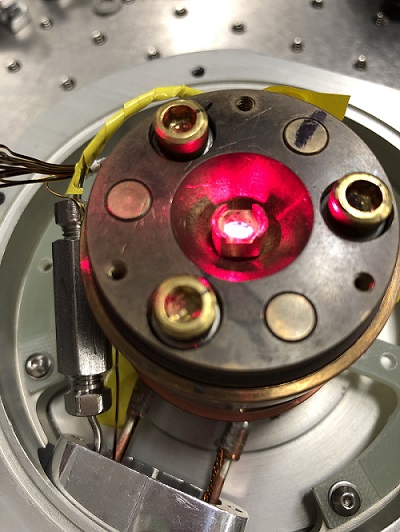Researchers at Caltech have reported success using lasers to dramatically sculpt the properties of materials without the production of excess heat, which can damage the materials.
“These tools could let you transform the electronic properties of materials at the flick of a light switch,” said David Hsieh, a professor of physics at Caltech. “But the technologies have been limited by the problem of the lasers creating too much heat in the materials.”
“The lasers required for these experiments are very powerful so it’s hard to not heat up and damage the materials,” said graduate student Junyi Shan. “On the one hand, we want the material to be subjected to very intense laser light. On the other hand, we don’t want the material to absorb any of that light at all.”

A strong laser is seen illuminating a material in a low-temperature chamber. The laser is being used to change the material’s degree of transparency. Courtesy of David Hsieh Laboratory, Caltech.
To get around the bottleneck, the team fine-tuned the frequency of a laser in such a way that it markedly changed a material’s properties without imparting any unwanted heat. The team also found what it called an ideal material to demonstrate the technique: manganese phosphor trisulfide — a semiconductor that naturally absorbs only a small amount of light over a broad range of infrared frequencies.
For its experiments, the team used intense infrared laser pulses, each lasting about 10−13 seconds, to rapidly change the energy of electrons inside the material. The team observed a shift in the material from a highly opaque state, for certain colors of light, to a highly transparent state.
The laser light altered the differences between the energy levels of electrons in the semiconductor (called bandgaps) without kicking the electrons themselves into different energy levels, which is what generates heat.
“It is as if you have a boat, and then a big wave comes along and vigorously rocks the boat up and down without causing any of the passengers to fall down,” Hsieh said. “Our laser is vigorously rocking the energy levels of the material, and that alters the materials’ properties, but the electrons stay put.”
Importantly, the process is reversible, the researchers said; when the laser turns off, the material returns instantly to its original state completely unscathed. This would not be the case had the material absorbed heat from the laser as the heat would need to dissipate.
Researchers previously theorized how this method would work. In the 1960s, Jon Shirley put forth mathematical ideas about how to solve for electron-energy levels in a material in the presence of light. Building on this work, Hsieh’s Caltech team collaborated with theorists Mengxing Ye and Leon Balents from UC Santa Barbara to calculate the expected effects of laser illumination in manganese phosphor trisulfide. The theory matched the experiments with remarkable accuracy, Hsieh said.
The findings give researchers the potential ability to use light to artificially create materials, such as exotic quantum magnets, which would have been otherwise difficult or even impossible to create naturally, Hsieh said.
“This is an alternative way of doing materials science,” Shan said. “Rather than making new materials to realize different properties, we can take just one material and ultimately give it a broad range of useful properties.”
The research was published in Nature (www.doi.org/10.1038/s41586-021-04051-8).